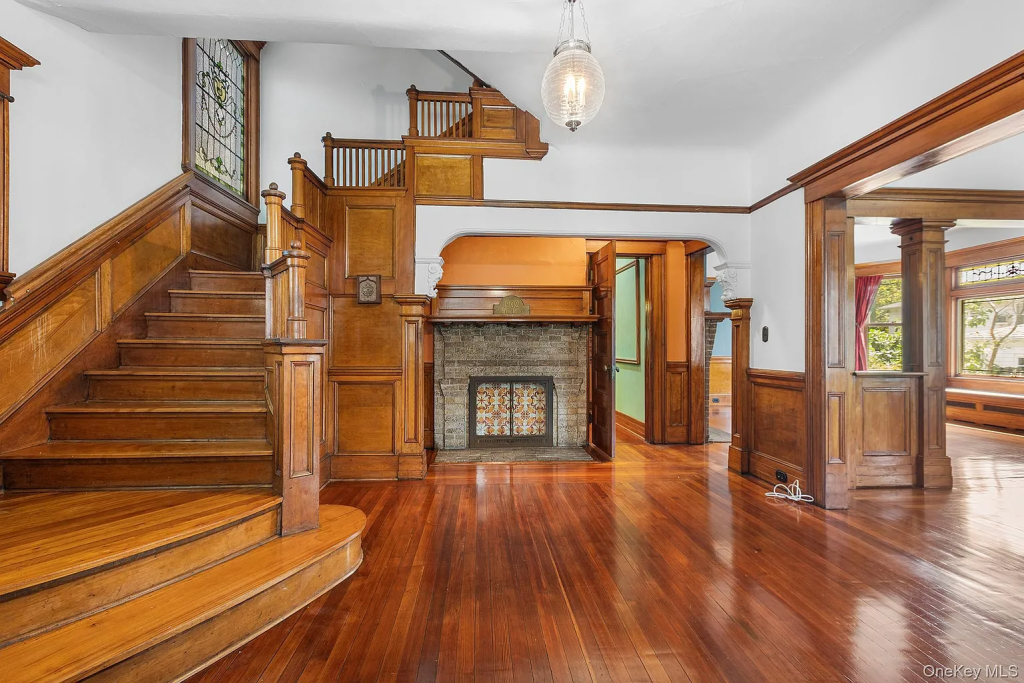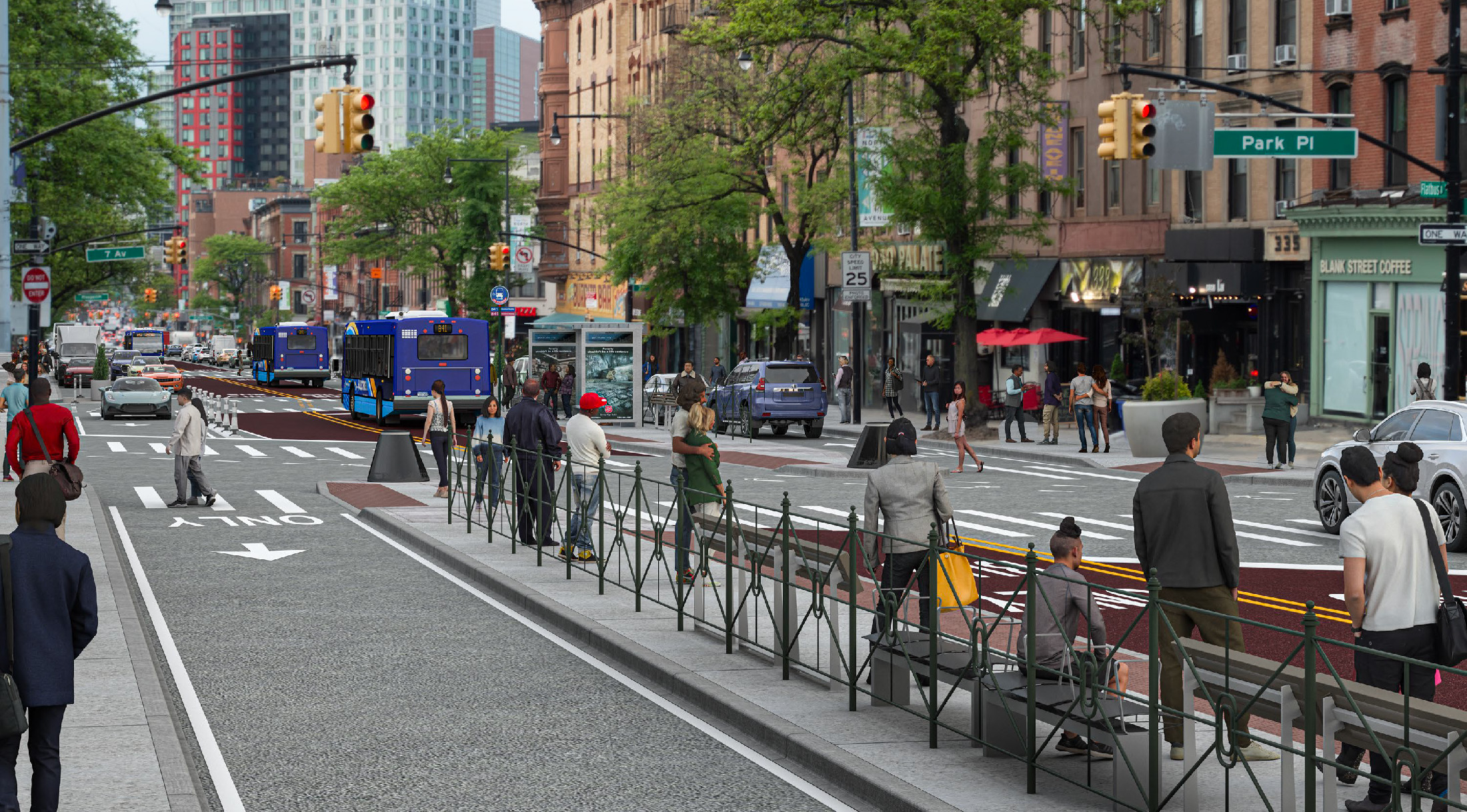Piece of Historic Wallabout Threatened by Developers
The group of four large commercial properties that take up the entire western side of Hall Street (at left in the bottom photo) between Flushing and Park Avenues in Wallabout—two of which (30 Hall and 12 Hall, pictured at top) are of architectural and historic significance—quietly changed hands last December for $10 million. The new…




The group of four large commercial properties that take up the entire western side of Hall Street (at left in the bottom photo) between Flushing and Park Avenues in Wallabout—two of which (30 Hall and 12 Hall, pictured at top) are of architectural and historic significance—quietly changed hands last December for $10 million. The new buyers, the team behind HK Management that includes Harry Kotowitz, Howie Klaus and Jeffrey Sitt, have been taking pains to keep a low profile as they seek the city’s complicity in their plot to destroy a piece of Wallabout history.
Architectural historian and Columbia prof Andrew Dolkart discussed the buildings in his 2005 survey of the Wallabout area:
The buildings that survive on the west side of Hall Street were erected by two wholesale grocery businesses. E. Le Grand Beers, who also erected buildings on the east side of Washington Avenue, commissioned the large, seven-story, brick (later stuccoed over), cold storage warehouse at 30-38 Hall Street from George Chappell in 1898. This building was extended to the north (Nos. 24-28) in 1918. Charles Hutwelker commissioned two cold storage buildings to the north, both designed by C. E. Huntley & Co. Hutwelker was a meat packer who went into business in Brooklyn in 1884. The Hall Street warehouses were initially occupied by the Charles Hutwelker Beef Export Company. No. 14-16 was designed in 1909 and No. 18-22 in 1919. These buildings could be included within a Wallabout Industrial Historic District.
As some of you may be aware, earlier in the 20th century, the city’s biggest open market used to be held across Flushing Avenue from these buildings in what’s now the Navy Yard; as a result, the large buildings in the immediate area were home to many of the city’s biggest grocery companies. In addition, as was pointed out to us by one of the preservationists working on the Wallabout Historic District application, the large awning (photo on the jump) that runs along the entire front of 55 Washington and 30 Hall, is also significant. These two buildings also sit directly across the street from the complex of reinforced-concrete buildings built for the Mergenthaler Linotype company in the earlt part of the 20th century. According to Dolkart, “The entire complex should be designated as a New York City landmark as soon as possible in order to preserve the original features of this architecturally and historically significant complex.”
The ability of these buildings to be included in the Wallabout Historic District (which is still pushing to get in front of LPC) is now threatened by the recent assumption of ownership by HK Management, whose recent track record includes snubbing Dumbo preservationists and pulling the rug out from underneath buyers at 99 Gold Street. HK has already been taking the temperature of local politicians to see if they’d support an application to the BSA to tear down all the buildings to build new residential. What’s interesting is that the four properties (2, 12, 30 and 40 Hall Street) are already overbuilt: Collectively they have about 200,000 square feet of interior space on about 70,000 square feet of lot space, well in excess of the 2 FAR for the area.
If the city does ultimately consider granting a variance for residential in this case, we sincerely hope it will look to the current Domino Sugar Factory situation as a model and insist on the preservation and integration of the buildings at 12 and 30 Hall into any kind of a proposal by the developers. If you have any strong feelings about the future of these buildings or what kind of neighbors these developers are likely to make, we’d encourage you to drop an email to Council Member Letitia James at james@council.nyc.ny.us. Maybe the spectre of this destruction will be enough to get Tierney et al to focus a little harder on designating the Wallabout Historic District. We do hear that Tierney’s planning a tour of the area at some point this summer.
Wallabout Cultural Resource Survey [Myrtle Avenue] GMAP P*Shark DOB





Brownstoner is smoking crack again…something he is doing with increasing frequency as of late….
People like 10:24 and 10:25 scare me more than some of the developers with no vision. You think if you insult preservationists enough, we’ll go away? No way!
Why is it so hard for people to see that preserving those buildings of historic and architectural merit help make this city interesting and desireable both to those who already live here, and those who want to come? I don’t see the reasoning for wanting to tear down everything. Especially since 90% of the replacements to those teardowns are architectually bland, uninspiring, and devoid of mentioning, except as future teardowns themselves.
Do we want to create a disposable city in an age where more and more, we need to start thinking about the consequences of what we do – to the environment, to natural resources, and to our populations? Preserving our historic buildings, with plans for adaptive reuse, makes environmental sense, and makes our streetscapes interesting and vital. Old buildings were built to last, the fact that we have so many is a testament to the superior building skills of the last century. Why not build on those skills, and keep NY alive?
Aside from that, look at the buildings that have been reused – they consistantly sell better than most new construction. The Board of Ed building at 110 Livingston, the old factory buildings in Dumbo, Belltel – all do much better than the nearby new construction. That’s because people like living and working in a building with good bones and some history. When even luxury buildings today are reporting problems in shoddy construction only a few years after being built, is it no wonder people want older buildings, even with their own particular kinds of problems?
There is more to preserving Brooklyn, in particular, than just the brownstones. The people who lived in those brownstones also built and worked in the factory and warehouse buildings, and some of their names and legacies still pay salaries today. Even if those companies and the people who built them are long gone, they helped to put Brooklyn on the map, and helped it become the successful city it is. We owe it to them to try, whenever possible, to keep those legacies alive for the next generations.
Of course you can’t save everything, and not everything deserves to be saved, and not everything can be saved. No true preservationist has ever advocated that, and no one has said that on this board, including Mr. B. However, I, for one, don’t want to live in a city where there are no buildings older than I am. There are plenty of suburbs like that, and from what I can see, people are moving back from those places in droves, because living in a vital, thriving city means living in an architecturally vital city where old and new can be planned to enhance and complement each other. But only if we save those buildings that deserve to be saved. Andrew Dolcart has made a career of investigating and scribing the history of our borough’s great architecture. If he says they are significant, that’s good enough for me. Why not?
I really hate to have anything in common, including part of a genome, with the “tear it down” crowd, but I have to confess that the clip from Dolkart doesn’t make a convincing argument for the ‘significance’ of these buildings, on their own or contextually. The Domino building was a major employer until very recently and is an iconic emblem of Brooklyn’s fast-vanishing industrial past. These look like…ugly old warehouses in a nearly deserted area. If developers had to tear something down that was somewhat old, these would not have me up in tears all night…or am I missing something?
I say we raze everything downtown, including the Farragut, Ingersol and Whitman housing projects, the Navy Yard and everything from Myrtle to the Waterfront and from Flatbush to Kent (with the exception of new condo developments). Then build the equivalent of midtown Manhattan and give our borough a real downtown commercial district with 500 skyscrapers to pepper the Brooklyn skyline. Charge 1/2 the rent of Manhattan and Jersey City and watch corporations make their way to Brooklyn in droves.
The city and state should ED everything along this “not worth saving” section of Brooklyn and sell it to developers. Then they should use the proceeds to build subway transportation along the waterfront from the Verazzano to the Queensborough Bridge with various connections into Manhattan. Property owners would receive “fair market value” for their property and the borough economic future will be secured. We need grand, aggressive ubran plannng for Brooklyn!
I usually agree with bstoner but aren’t these buildings in poor shape. Anyone know what could actually be done with them?
BEAUTY? you are high high high. the area looks like a blighted s***hole. anyone who has the guts to sink their money into this neighborhood given its proximity to those projects and the bad element around myrtle should be able to do what ever they need to do to make money.
Come on could one person tell me what is architecturally significant about these buildings? – yes they are slightly old – but buildings like this are a dime a dozen and certainly dont deserve protection based on some sort of architectural uniqueness or breakthrough
i can’t believe the above posters can’t see the beauty and potential of those buildings. you guys would probably want to tear down all those old messed up buildings in venice too….i bet you love carpet too.
We need the commercial space here more than the residential at this point. Myrtle will have plenty of space for teardowns and new residents. This block needs a facelift but if its already overbuilt it would be stupid to tear it down.